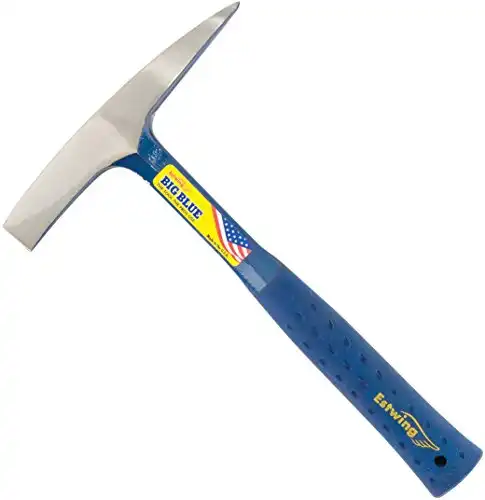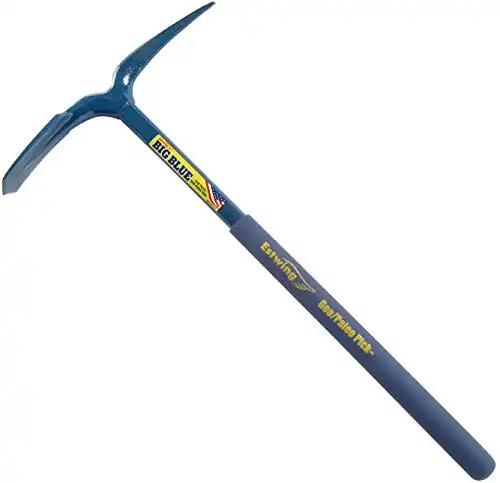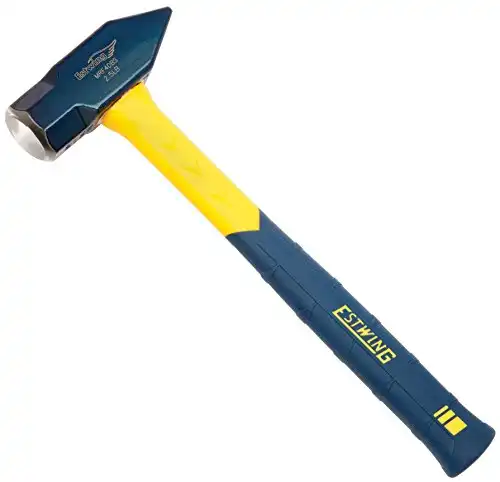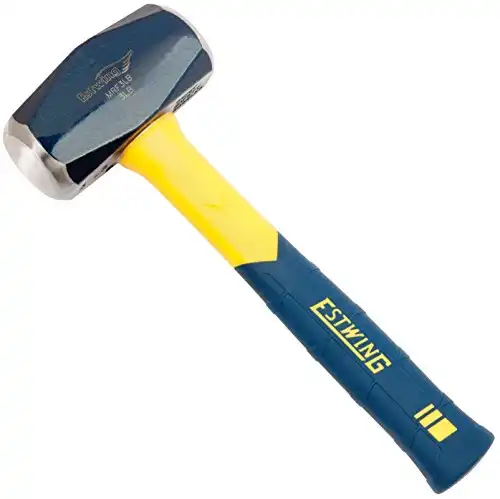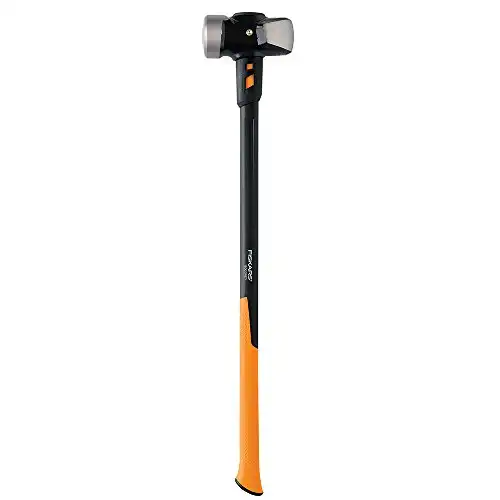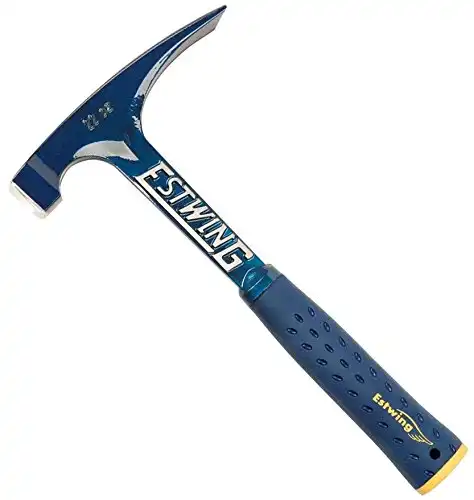Ultimate Guide to Rock Hammers
Every amateur geologist and rockhound needs to have at least one good rock hammer or rock pick in their geologist tool kit.
But before you get your hands on a rock hammer and start banging it against rocks, you should have some idea of how properly use these very important tools.
Keep reading to learn which rock hammer is the best rock hammer for amateur geologists and beginner rockhounds AND how to properly use one of these tools.
Rock Hammers Mentioned
Tips For Choosing a Rock Hammer
You probably already know there’s a wide variety of rock hammers available to amateur geologist and rock collectors. Just check out Estwings Geology section of their website. The reason there’re so many is because each type of rock hammer serves a specific purpose.
For example, there are specific rock hammers designed for smashing, some for prying and others for chipping and cracking.
Do you know which kind rock breaking tools you need? Keep reading for a list and a description of the different kinds of rock hammers. Use this information to choose which kind of rock hammer you want to add to your took kit.
Any one of these have potential to be the best rock hammer for amateur geologists. However, below I will share with you my top choice as best rock hammer.
Rock Hammer Guide
1. Mason’s Hammer/ Bricklayer’s Hammer
Features Of The Estwing Mason’s Rock Hammer or Bricklayers Rock Hammer
- Square head
- Chiseled end
- Cushioned handle
- Easily loosens hard soils
- Break rocks into small pieces
- Excellent control when precision is required.
- Quickly split soft rocks
- Can also be used as a chisel
2. Chipping Hammer
Features Of The Chipping Hammer Rock Hammer
- vertical chisel end used to fashion rock tiles
- pointed tip end.
- cushioned handles to
- Can deliver precise blows to small areas
3. Geo Pick/ Paleo Pick
Features Of The Geo Pick/Paleo Rock Hammer
- perfect digging tool for rockhounding and prospecting
- pointed end
- chisel edge
- excellent for tearing apart sedimentary rock and digging small holes.
4. Crack Hammer – (Best Tool For Breaking Rocks)
Features Of The Crack Hammer Rock Hammer
- excellent for breaking large rocks into smaller rocks
- two flat polished ends
- looks like small handheld sledgehammer
- Also used to drive chisels and point ends into rocks
5. Sledge Hammer
Features Of The Sledge Hammer Rock Hammer
- long handle
- A heavy tool used for breaking rocks
- break large size rocks into much smaller, manageable size pieces
- essential tool when working with big rocks
- can be difficult for some rock collectors to use.
6. Cross Peen Hammer
Features Of The Cross Peen Rock Hammer
- flat hammer face
- blunt chisel end
- great for reducing hand samples and driving chisels
- cushioned handle to protect hands
The Best Rock Hammer for Amateur Geologists and Beginner Rockhounds
The next thing to do is choose the best rock hammer that meets your specific need, whether you’re an amateur geologist or a beginner rockhound. Take into account what you’ll be using it for the most and choose the right rock hammer for your needs.
Will you be driving chisels and splitting rocks? Will you be working with sedimentary rock looking for fossils and making tiles? Perhaps you will be digging and unearthing thundereggs or geodes. There’s a “right” rock hammer for each of these jobs.
If You Only Were To Choose One Rock Hammer
Fact is, there are many different types of uses for a rock hammer. But If I could only have one rock hammer in my tool kit, I would choose this Estwing chipping hammer. It’s a versatile rock hammer, lightweight, can easily break small rocks into smaller sized pieces and is still quite affordable.
How To Use A Rock Hammer
The first rule to remember when learning how to use a rock hammer is to always use eye protection. There is not one rock or fossil out there that is worth losing your sight over.
The second rule of using a rock hammer is to use a good quality pair of gloves. If you try to use a rock hammer to crack a rock in your hand without using gloves, you will tear your hands to shreds.
How to Break Small Hand Samples With A Rock Hammer
Remember that rocks have extremely poor tensile strength. The easiest way to break a rock with a rock hammer is to take advantage of this natural weakness. If possible, apply the rock hammer so that the force of the blow induces tensile stress.
- cup your free hand, palm up, with the sample supported by the pads of your hand below your fingers.
- make sure you have space between your palm and the sample.
- Hit the center of the rock sample with a solid blow from the rock hammer. Make sure you hit “through” the sample, kind of like Bruce Lee punches “through” a board with his fist. The goal is to make the rock give, or bend, ever so slightly. With a little practice you’ll have a nice, fresh surface to inspect.
Tip: Choose your samples carefully. If the rock doesn’t break, your hand will absorb the energy of the blow from the rock hammer instead. Tabular or elongated samples will break easier than cubic or spherical shaped samples.
How to Break Larger Samples With A Rock Hammer
The same theory applies to break larger rock samples as it does to breaking smaller, hand held size rock samples, that is…take advantage of the rocks natural weakness with the rock hammer.
- For larger samples, try to immobilize the sample under your foot to eliminate any “give”.
- Strike the rock hammer on the exposed part of the rock.
- If the rock doesn’t break, or all you end up doing is make dust, then stop and regroup. It’s not being done correctly.
- Remember, breaking larger rocks efficiently takes practice. Don’t be afraid to turn or adjust the rock sample during this process.
Consider the crack hammer if strictly looking for the best tool to break rocks.
Rock Hammer Tips and Things to Remember
- First tip for rock hammer safety is to always use eye protection when using a rock hammer
- Choose the right rock hammer for your needs. I’ve chosen the Estwing chipping rock hammer.
- Know what kind of rock you will be hitting. There are many different kinds of rock that is much harder than your rock hammer. This can damage your hammer, and worst, inflict damage on you!
- Don’t use your rock hammer for things other than what it was designed for. Don’t use your rock hammer as a chisel. Use a rock chisel as a chisel.
- Use your body as leverage instead of using only arm strength. This will maximize the force delivered by the rock hammer.
- Pry with the chisel end of the rock hammer. Don’t use the chisel end to smash rocks
- Invest in a nice chisel to use with your rock hammer. It will save you a lot of money to wear out a ten dollar chisel than a forty dollar rock hammer.
- Make sure you hit what you’re aiming at, and know what’s behind the swing. If you miss, what will you hit? Your leg? Another body part?
- Don’t use a rock hammer as a chisel and strike it with another hammer
- Again…always use eye protection when using a rock hammer.
The best way to learn how to use a rock hammer is to get out there and practice. Be safe and have fun! Leave a comment below if you have any tips or tricks on using rock hammers.
Conclusion
So now that you’ve got a good start on how to find the best rock hammer for beginners, where do you go from here? If you’re looking for information on other rockhounding tools, you may want to take a look at my post, The Ultimate Guide To Rockhounding Tools.
In this post, I not only go through all the rock hammers we talked about here, but I also describe in detail all the other tools a successful rockhound needs.
Happy Rock Seeking!
- Online rock and mineral club for collectors of all levels!
- Find community with like-minded rock and mineral enthusiasts.
- Monthly Giveaways!
- Free Access to Entire Digital Library of Products (current and future products)*

